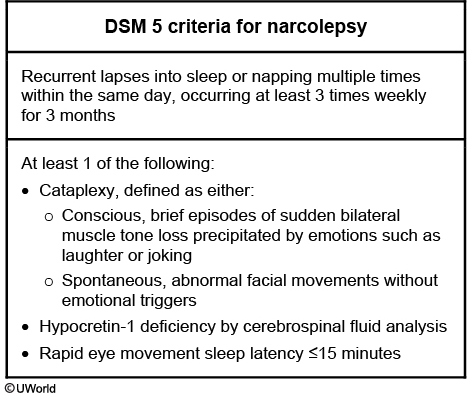narcolepsy

- Sx include: fragmented sleep, hypnagogic hallucinations, sudden onset of sleep during day
- Population: teen to late 20s

- Diagnosed by sleep study/polysomnography
- multiple spontaneous awakenings
- reduced sleep efficiency (total sleep time divided by total recording time)
- reduced latency of rapid eye movement (REM) sleep.
- Polysomnography can also exclude other causes of EDS (excessive day time sleepiness) (eg, sleep apnea).
- goal: reduced excessive day time sleepiness
- modafinil: novel stimulant, less addictive, first line
- older stimulants: methylphenidate, amphetamines
- effective but addictive
- bad side effects
- nonpharmacologic:
- taking scheduled naps
- good sleep hygiene
- sudden onset of muscle weakness
- triggers: intense emotional episodes (eg, anger, laughing, surprise)
- occurs in roughly 70% of patients with narcolepsy.
- Treatment: stimulants, nonpharmacologic
- can be treated with a serotonin-norepinephrine reuptake inhibitor (eg, venlafaxine) or selective serotonin reuptake inhibitor, and a tricyclic antidepressant can also be considered.
- Sodium oxybate (the salt form of gamma-hydroxybutyrate) can improve nocturnal sleep, relieve excessive daytime sleepiness and has anti-cataplectic properties; however, it is rarely used due to abuse potential and restrictive regulations.
Backlinks

